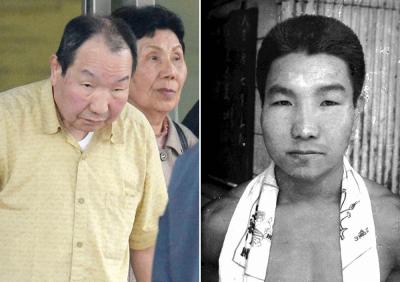Japan frees world’s longest-serving death row inmate after more than 45 years
Forty-eight years. Forty-eight years of professed innocence. Forty-eight years of incarceration, 30 of which were in solitary confinement. Forty-eight years since June 10, 1966 when two children and their parents were stabbed to death and their home set ablaze. And 48 years since Iwao Hakamada, the longest-serving death row inmate in the world, was arrested, thrown in jail and ultimately sentenced to death for it.
Hakamada, a former professional boxer who is now 78, was freed Thursday morning after a Japanese court concluded investigators had likely fabricated evidence during his 1968 trial, the Associated Press reports. Hunch-backed and wearing a yellow button-down, he waddled into an awaiting car amid a gaggle of flashing cameras. The decision to free him comes a month after the exoneration and release of America’s longest-serving death row inmate, Glenn Ford.
Blood on a shirt prosecutors alleged Hakamada wore during the family’s murder turned out not to contain his DNA. The court ordered a retrial, calling Hakamada’s original verdict an injustice. Prosecutors say they’ll appeal.
The order marks only the sixth time in Japan’s postwar history that a death row inmate has been awarded a retrial, AP reports, and the decision may ignite more criticism of a capital justice system that has come under attack before. Japan and the United States are the only two Group of Seven nations to maintain the death penalty, and it retains great popularity in Japan.
But there are significant problems, critics say. Death row inmates, who are hanged, don’t know the date of their execution until the morning of that date arrives. “For decades,” Reuters reports, “Japan did not even officially announce that capital sentences had been carried out.” And perhaps most troubling of all, police obtain confessions in closed-door interrogations, opening up the possibility of a false confession.
Which is exactly what Hakamada says happened to him.
In 1966, Hakamada was 30. He was handsome and had just retired from boxing after once ranking sixth in Japan’s featherweight class. He’d taken a job in the town of Shimizu nestled along Japan’s southern coast at a food-processing factory. On June 30 of that year, the factory’s manager and his wife and two children were found stabbed to death. Someone had also stolen 200,000 yen — $2,000 –from their house, which had been razed.
Two months later in August, Hakamada was arrested, charged with murder, robbery and arson. While in custody, he said he did it. He later recanted the confession, but it was too late. On September 11, 1968, a three-judge panel sentenced him to death.
The case wasn’t nearly as solid as it appeared that day. The sentencing haunted one of the judges. “I have thought about his trial for many years,” judge Norimichi Kumamoto told reporters in 2007. ”The guilty verdict was based solely on Hakamada confessing to the killings. But he confessed after being confined and tortured in a small room for 20 days. … The police use shocking, barbaric means to extract confessions and those who make them do so only out of despair.”
“I have felt sadness and disappointment over this,” Kumamoto continued.
Despite that admission, Hakamada languished on death row for seven more years, always unsure if every day was to be his last. He was eventually admitted into the Guinness Book of World Records as the globe’s longest-serving death row inmate.
If previous cases offer guidance, Hakamada’s chances at retrial are good. Four of the other five death row inmates who were tried a second time were acquitted. The other case is pending.
Hakamada’s sister, who has condemned her brother’s ruling for decades, grinned when she heard the news. ”I want to see him as soon as I can and tell him, ‘You really persevered,’” she told reporters. “I want to tell him that very soon now, he will be free.”
By Terrence McCoy, Updated: March 27 at 4:24 am

